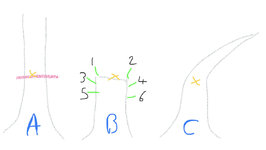AndyJ
Shohin
Hey folks.
I’ve got what is probably a really dumb question but here goes anyway! When you do a trunk chop on a tree, how do you select the shoot that you want to use to take on the new trunk line the following spring? In my example, below (please excuse the crap graphic!),
- “A” is a four year old tree that was trunk chopped
- “B” shows the resulting buds that appear after trunk chop and
- “C” where I want the tree to grow
I want my new leader to grow up and off to the right and create one of those really nice transitions - my logic says that to do this, I should select shoot “2”. However, if I do this, what happens to trunk “z” to the left of shoot “2”? If I select shoot ”1” do I wire it over the top of the top of the trunk “z”? Won’t this cause a bulge?
If my chopped trunk doesn’t produce shoots “1” & “2” but shoots “3” & “4” instead, what do I do then?
Apologies if this is really obvious - am I just making it more complicated than it actually is?!
Thanks all

I’ve got what is probably a really dumb question but here goes anyway! When you do a trunk chop on a tree, how do you select the shoot that you want to use to take on the new trunk line the following spring? In my example, below (please excuse the crap graphic!),
- “A” is a four year old tree that was trunk chopped
- “B” shows the resulting buds that appear after trunk chop and
- “C” where I want the tree to grow
I want my new leader to grow up and off to the right and create one of those really nice transitions - my logic says that to do this, I should select shoot “2”. However, if I do this, what happens to trunk “z” to the left of shoot “2”? If I select shoot ”1” do I wire it over the top of the top of the trunk “z”? Won’t this cause a bulge?
If my chopped trunk doesn’t produce shoots “1” & “2” but shoots “3” & “4” instead, what do I do then?
Apologies if this is really obvious - am I just making it more complicated than it actually is?!
Thanks all





